Omnichannel contact center: The practical guide

Customer Support Manager - Tier 1

Tags
Share
If your customers are reaching out through a variety of channels—live chat, messaging apps, email, social media, and beyond—then your contact center strategy needs to keep up.
According to McKinsey, customers are becoming increasingly “channel-agnostic, using up to ten channels to make purchases in 2021, compared with five in 2016.” Not only that, an omnichannel contact center strategy is also key to driving revenue and profitability—”companies that implement omnichannel transformations report revenue growth of 5 to 15 percent and improvements in cost-to-serve efficiencies of 3 to 7 percent.”
That shift in behavior (and the business impact it creates) makes one thing clear: delivering consistent, connected customer experiences across every touchpoint is a competitive advantage—for the leaders who are able to prioritize it.
In this guide, I’ll walk you through what that entails, how to equip your customer service agents or outbound sales reps to streamline conversations across different channels and platforms in real-time—and what to look for in an omnichannel contact center solution.
Read on as I share the insights I’ve gained over years working as a Customer Support Manager.
What is an omnichannel contact center?
An omnichannel contact center is a department or contact center team in a company that handles high volumes of communications with customers, prospects, or other audiences across their preferred channels.
But more importantly, the conversational data and context across these channels are all automatically synced with each other. This means that customers can, for example, start conversations with your business in a direct message on LinkedIn, then transfer to a web chat with a bot, before choosing to have a phone call with relevant information at a convenient time for them. All that chat history, regardless of channel, is logged and easily accessible by your agents without them having to dig through databases or different software.
To manage these tasks, many contact centers use specialized software—specifically an omnichannel contact center solution that lets agents and supervisors efficiently manage communications across all channels including voice, video, and digital channels like social messaging:
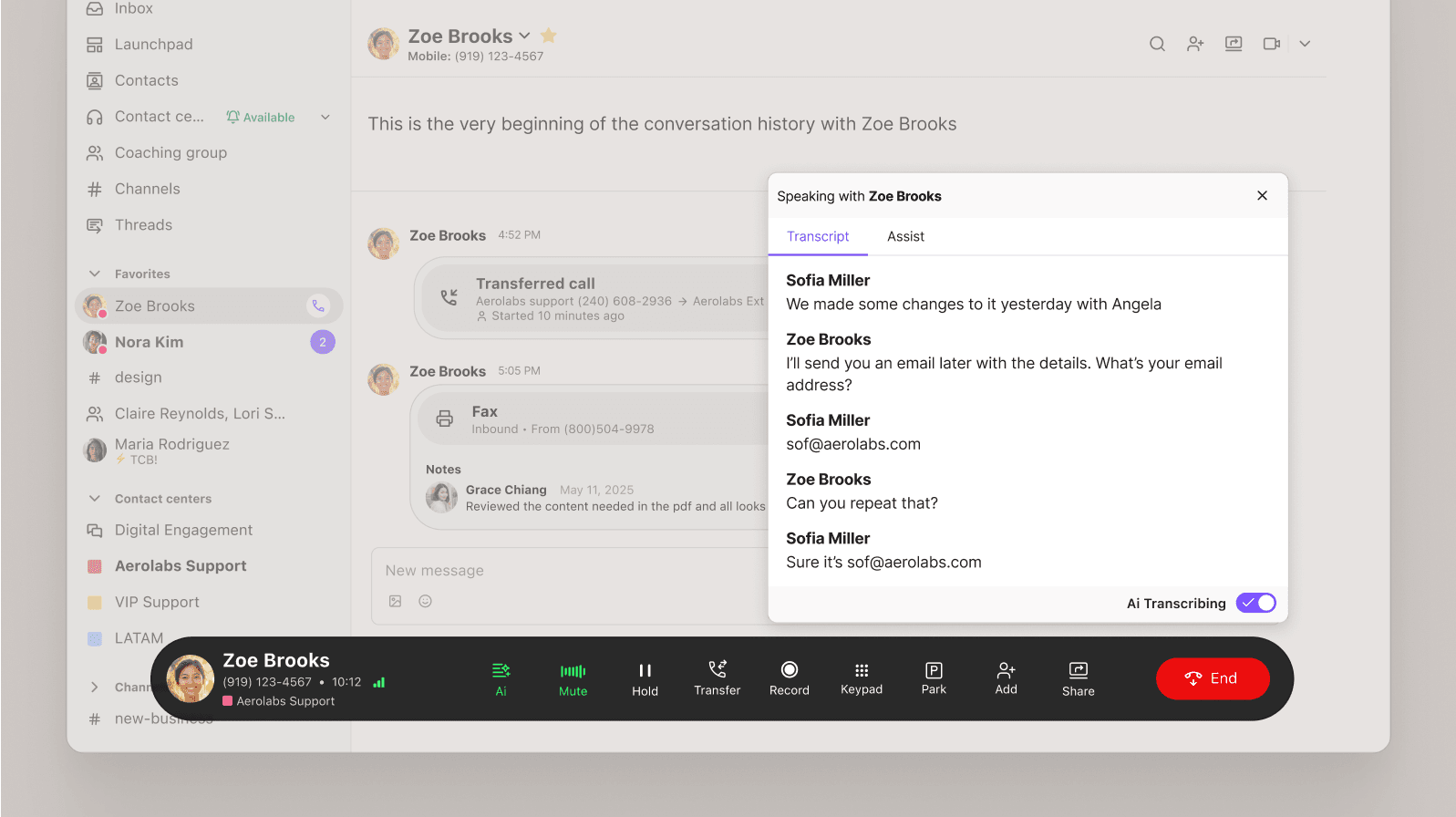
Omnichannel vs. multichannel contact centers
Multichannel contact centers also allow customers to reach out using different channels, but that’s where the similarities with omnichannel contact centers end. With multichannel contact center platforms, conversations and interactions are siloed and separated by channel.
Here’s an example:
A customer has an issue with a desk they bought, and emails the company for a replacement part.
Upon receiving the email, a customer service agent writes a reply to the customer. It takes a few days because emails tend to have longer SLAs (service levels / response times) than, say, a live chat or phone call.
During this time, the customer gets impatient, follows up with a phone call, and speaks to a different agent. They ask about the replacement part they requested. This new agent has no customer transaction history and is unaware of the email the customer has already sent, including the important information about that request.
In a multichannel contact center, these steps in the omnichannel customer journey remain separate. Or, as your customers might put it, “the left hand doesn’t know what the right hand is doing.”
With an omnichannel customer service platform, conversations and customer data are synced across all channels in real-time. That means every agent has full context for any past interactions when they answer questions, which means faster response times, higher agent productivity, and ultimately, happier customers.
Here’s a quick comparison of a multichannel vs. omnichannel contact center:
Omnichannel contact center | Multichannel contact center |
Supports multiple channels | Supports multiple channels |
Channels run in harmony with full visibility | Each channel runs siloed from the others |
Agents can access all channels from the same platform | Agents might use different software to access each channel |
Agents can seamlessly switch between communication channels | Conversation history doesn’t get automatically synced across channels |
Includes CRM integration for relevant customer data | May integrate with CRMs |
Offers real-time metrics on customer activity | May not offer real-time data or metrics |
Key benefits of an omnichannel contact center platform
Before we get into the specific advantages, it’s worth asking: Why consider an omnichannel platform in the first place?
Take a closer look at how your customers currently get in touch. Consider questions like:
Are your customer service agents suffering from disjointed conversations?
Are your call and messaging volumes getting out of hand?
Are your support agents often overwhelmed?
If you answered “yes” to any one of these questions, it may be a sign that your existing setup is increasing rather than reducing friction. An omnichannel contact center can help by bringing all your customer conversations—across all touchpoints—into one space.
Here are three of the biggest benefits:
It boosts customer satisfaction by meeting them where they are
Today’s customers expect convenience, and they’re defining that on their own terms. That might mean starting a conversation on live chat, continuing over SMS, and wrapping up with a call. An omnichannel platform enables seamless transitions between those channels without making the customer repeat themselves—even if they get transferred between different agents (whether human or Ai).
Add Ai-driven tools like intelligent chatbots and predictive routing, and customers can get help faster, often without needing to wait for a live agent. That kind of frictionless experience translates into higher CSAT scores, stronger loyalty, and fewer abandoned interactions.
It drives agent efficiency and reduces burnout
Because omnichannel contact center platforms unify customer data, context, and communication history into a single view, that results in way less tab-switching and guesswork for agents.
For example, in a retail contact center, instead of toggling between multiple systems to find order details, shipping info, and past interactions, an agent can see everything in one place—right when the call or chat comes in. This not only speeds up the conversation, but also helps agents personalize responses and impress customers by being ready to go as soon as they say hello.
And because routine questions can now be handled by Ai or self-service flows (like dynamic FAQs or voicebots), human agents are freed up to handle the high-value, complex issues where they’re truly needed. The result? Faster response times, lower average handle times, and reduced agent frustration.
This kind of streamlined experience isn’t just theory—it’s already making a real difference for forward-thinking support teams. Companies like Custom Ink have seen firsthand how centralizing communications and tools into one platform can transform day-to-day operations, especially when it comes to improving internal collaboration and reducing the time it takes to resolve customer issues.
“In our previous system, we had very limited visibility into calls,” Arielle recalls. “Accessing a call required running separate internal reports, making collaboration challenging, especially during escalations when multiple leaders needed to review the same call. Now, with Dialpad, everyone can easily access calls, leave notes, and collaborate in real-time. It’s been a game changer for us.”
It unlocks better insights and smarter decision-making
Every interaction across voice, chat, email, and social media generates valuable data. Omnichannel platforms consolidate all of that into one place, making it easier to track customer behavior trends, monitor channel performance, and identify friction points.
For example, let’s go back to our retail example, and let’s say a contact center manager notices a spike in chat volume related to order tracking right after a product launch. With a traditional setup, this insight might be buried across separate systems for chat, email, and voice support. But with omnichannel contact center software, it’s easy to spot the trend in real time, drill into the root cause, and take action—like updating the shipping FAQ, tweaking messaging on the website, or proactively sending status updates via SMS.
It reduces tech bloat—and keeps IT and finance happy
Managing customer service across disconnected tools—one for calls, another for live chat, a third for social media, and yet another for analytics—leads to mounting tech bloat. Not only does this create complexity for contact center agents and supervisors, it also results in overlapping costs, redundant systems, and more vendor contracts to manage.
By consolidating channels, reporting, and automation into a single omnichannel platform, companies can streamline their tech stack and eliminate unnecessary software. That means fewer integration headaches for IT, simplified maintenance, and lower total cost of ownership. And Finance benefits too—thanks to clearer ROI, fewer surprise renewals, and cleaner budgeting across departments.
It’s a win-win-win: smoother workflows for agents, less technical overhead for IT, and better cost control for Finance.
Features to look for in omnichannel contact center solutions
Not all contact center platforms are created equal—and when it comes to omnichannel, the difference between a patchwork suite of tools and a unified solution can make or break your customer experience. As you evaluate providers, keep an eye out for features that don’t just support multiple channels, but actually connect them in a way that simplifies workflows, enhances agent productivity, and keeps every conversation in context.
A truly unified CCaaS + UCaaS platform
Most businesses today can’t afford to separate internal and external communications, especially with hybrid work and real-time customer engagement now the norm. That’s why choosing a provider that offers both CCaaS (Contact Center as a Service) and UCaaS (Unified Communications as a Service) on a single platform is one of the best choices you can make when building out or upgrading your tech stack.
CCaaS powers external-facing communications: think customer support, sales, and high-volume inbound or outbound interactions.
UCaaS covers your internal team collaboration: voice, video meetings, messaging, and more.
After all, even contact center agents need a solid UCaaS solution to collaborate with teammates and managers. The fewer silos, the better.
Dialpad stands out here by offering fully integrated CCaaS and UCaaS in one experience—with one login, one admin portal, and one clean interface. Make IVR changes, adjust call routing, and talk with teammates across devices—all without juggling tools or accounts.
Oh, and it works on desktop, mobile, and even in your browser—no downloads required—for a truly flexible, work-from-anywhere experience.
Easy drag-and-drop (no-code) chatbot building
The transition to an omnichannel contact center shouldn’t mean weeks of onboarding or hiring a dev team. Look for a platform that includes intuitive, no-code tools for building and managing Ai chatbots, call flows, and IVRs.
With drag-and-drop builders, anyone—technical or not—can launch smart customer-facing workflows in minutes. Need to update a holiday hours message or change routing for VIP customers? Do it without opening a support ticket.
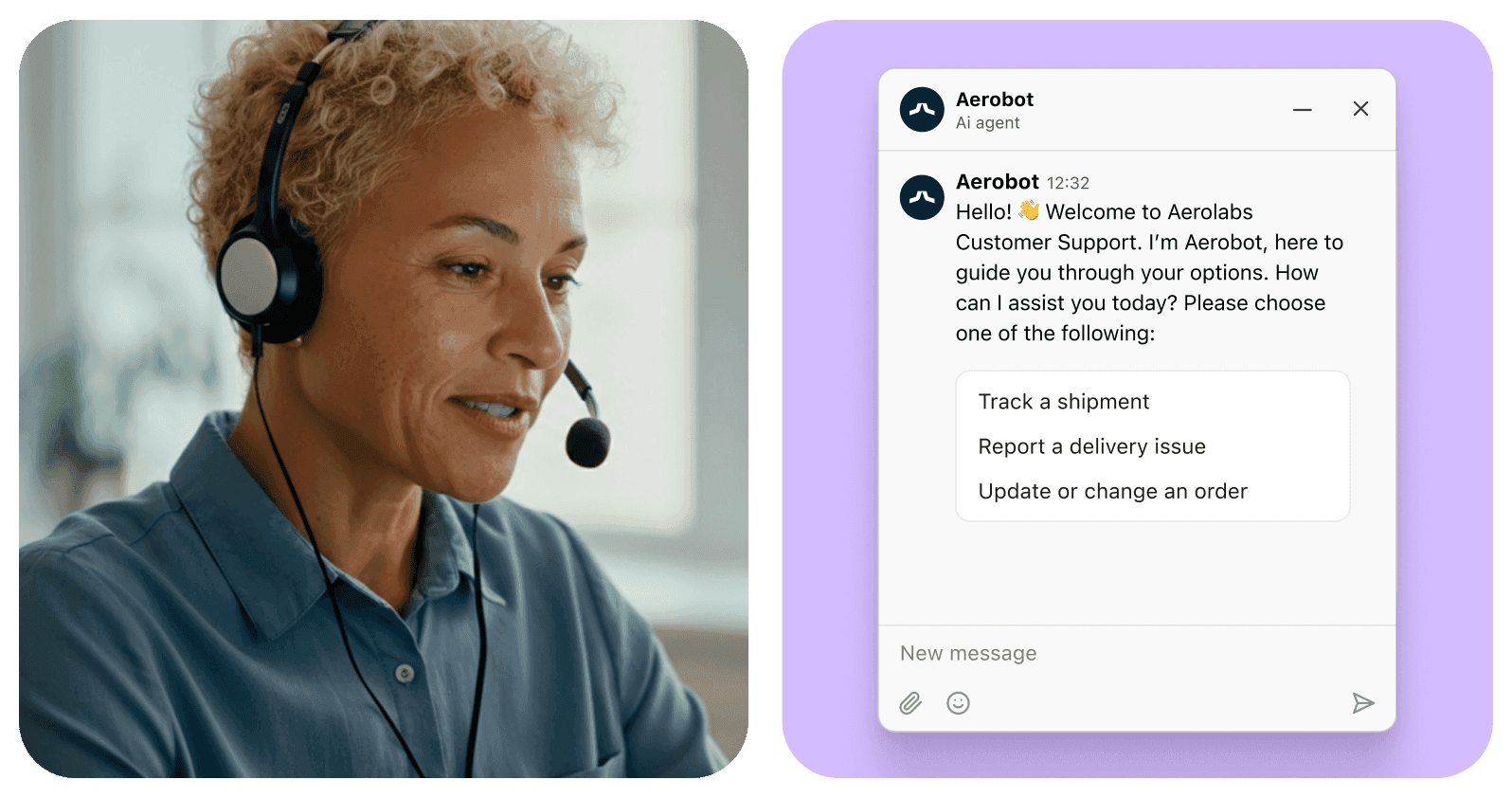
Built-in Ai, not bolted-on Ai
Ai isn’t a buzzword anymore—it’s a critical component of modern contact center operations. But with Ai, it’s important to understand how exactly those Ai features are built. Very few contact center platforms have their own proprietary Ai, and many vendors rely on third-party plug-ins with partners like OpenAI and/or charge extra for advanced features.
Dialpad Ai is fully built in and continuously improving, with functionality designed to lighten both agents' and supervisors’ load:
Real-time voice transcription for calls and meetings
Live customer sentiment analysis to flag at-risk conversations
Keyword tracking for topics like “refunds” or “cancel,” so managers can spot trends instantly
Ai Live Coach Cards that pop up relevant coaching tips when specific words are mentioned—perfect for onboarding new agents or supporting tough conversations at scale
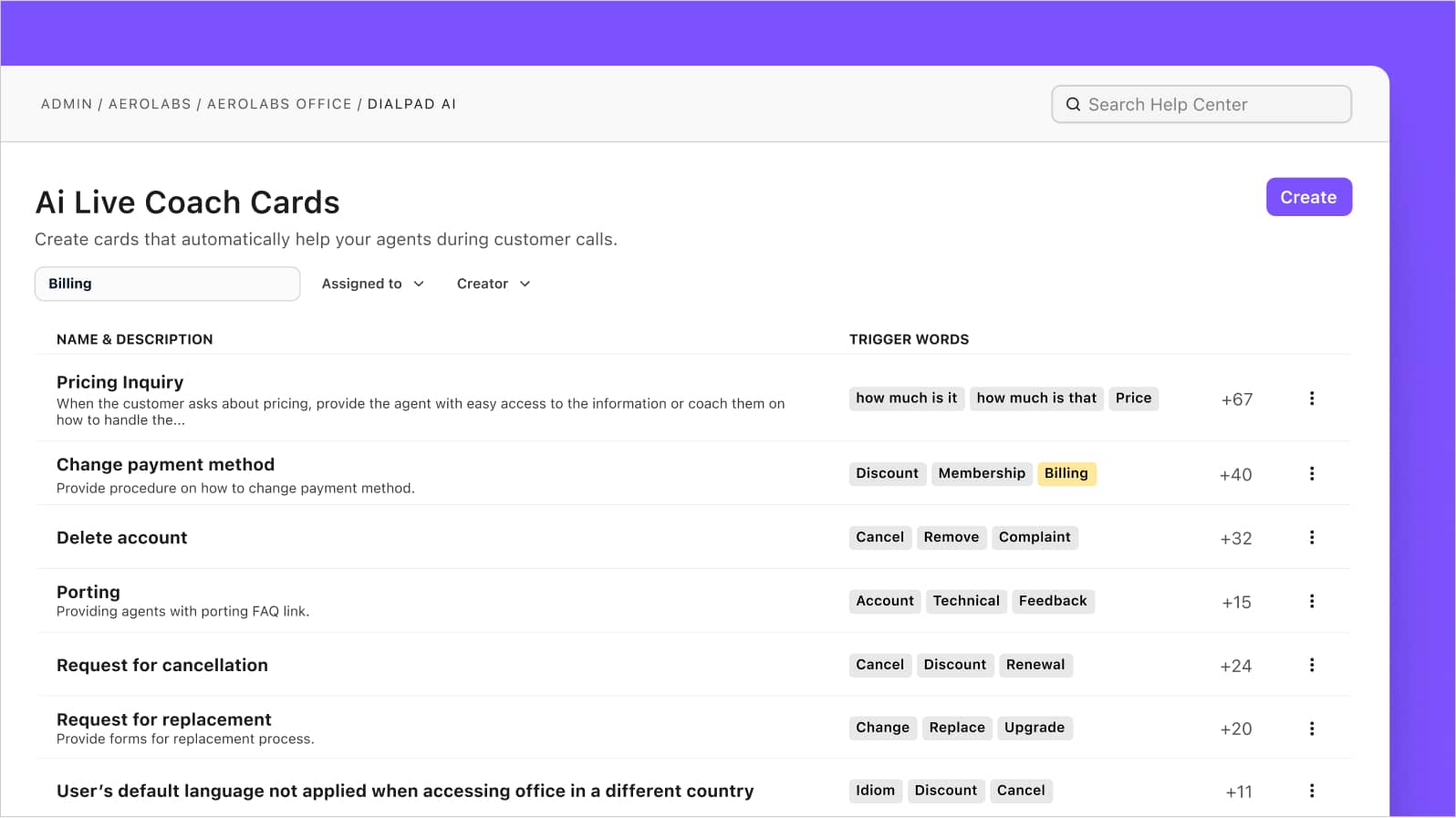
These features don’t just make your team smarter—they help agents by making their workflows faster, more consistent, and more scalable.
Always-on, global support
If your support team is expected to be online 24/7, then your contact center provider should be too. Be sure to vet support offerings carefully and ask questions like:
Is phone, chat, and web support included, or is it an add-on?
Are there extra charges per ticket or minute?
Do they offer a dedicated rep at your scale?
Fun fact: Dialpad provides 24/7 global support across all channels, with no surprise fees—and has a 100% uptime SLA for customers on Enterprise plans.
Seamless integrations with your existing tools
Your omnichannel cloud contact center platform should connect naturally to the rest of your tech stack—not create more work. The right integrations can streamline agent workflows, eliminate redundant data entry, and provide a more connected customer experience.
Dialpad integrates deeply with CRMs like Salesforce, HubSpot, and Zoho, as well as productivity suites like Google Workspace and Microsoft 365.
Here’s an example. Dialpad has an integration with Salesforce. No big deal, most contact center software has an integration with Salesforce. But, Dialpad’s integration works on mobile app too (it’s one of the very few, if not the only one that does this—most integrations only work on desktop).
Not only that, the integration also brings in Dialpad’s Ai features (like Ai Live Coach Cards) into Salesforce and embeds a CTI (computer telephony integration) dialer to let agents make phone calls directly from the CRM dashboard:
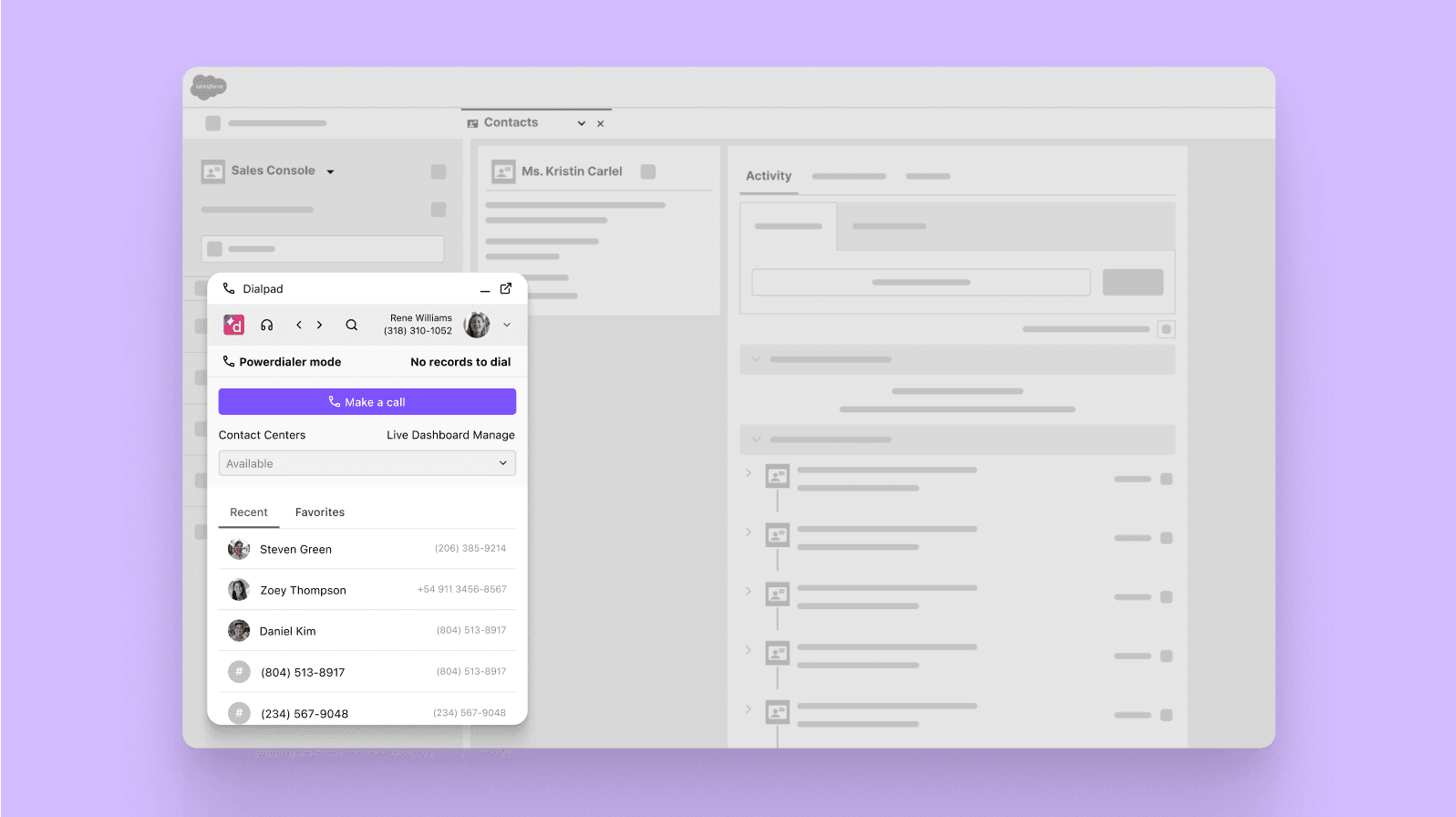
Selecting the best omnichannel contact center software for your business
Finding the right omnichannel contact center solution isn’t just about ticking boxes on a list of features—what’s more important is aligning your shortlist of providers with your team’s workflow, your customers’ expectations, and your long-term growth strategy.
Here are five simple questions to help guide your evaluation as you’re getting started:
1. Does it support both UCaaS and CCaaS in one platform?
Consolidation is about convenience, yes—but you should also be considering how your contact center provider will minimize complexity, improve reporting, and help you save on cost. A truly unified platform will let your team handle both internal and external conversations without having to toggle between apps or copy and paste data back and forth.
2. How easy is it to set up and manage?
Look for no-code tools, intuitive interfaces, and flexibility for admins. For example, if you need a developer for little changes like updates to your call routing or creating a new conversational Ai flow, that’s a red flag.
3. Is Ai a core part of the platform—or just an add-on?
Native Ai will future-proof your operations and deliver far better performance and consistency than third-party bolt-ons. It also reduces security risks by keeping sensitive data within a single platform, rather than routing it through external vendors. Plus, because it’s deeply integrated with your workflows and data, it tends to produce more accurate, context-aware outputs.
4. What level of support is included—and is it truly 24/7?
Make sure you understand what's covered, what’s extra, and whether you’ll have access to help during the peak periods when you need it most. If you operate globally or outside of typical business hours, ensure your provider’s support model won’t leave you stranded when something goes wrong.
5. Will it integrate easily with the tools your team already uses?
From CRMs to collaboration platforms, seamless integrations will save your agents time and reduce operational friction. For this one, you’ll likely need to take some time to get a demo or try a free trial to really get a sense of what the user interface for each integration is like and what it can actually do.
Look for integrations that go beyond basic data exports, with features like two-way sync, automated logging, and in-app Ai functionality.
Strategies for omnichannel contact center implementation and success
Once you’ve selected your omnichannel contact center software, the real work begins. Implementation isn’t just about setup—it’s about operationalizing your strategy to deliver seamless, consistent, and scalable customer experiences across every channel. Here’s how to do it right from day one.
1. Map your customer journey across all channels—online and offline
Before you roll out your new platform, take time to audit how and where your customers are interacting with your business. From in-store conversations and phone calls to social media DMs and live chat, every touchpoint matters.
Mapping the full journey—including both digital and offline interactions—helps ensure your platform is configured to meet customers where they actually are, not just where you think they are. This step sets the foundation for prioritization, staffing, and workflow design.
2. Prioritize channels based on actual customer behavior
Omnichannel doesn’t mean “every channel all the time.” Instead, focus on the communication channels that your customers use most frequently and that generate the highest value interactions.
Use your platform’s analytics (or your CRM) to determine which channels see the most volume or the most complex queries. That data will help you allocate agent headcount, automate intelligently, and avoid spreading your resources too thin.
With Dialpad Support, for example, you can manage all your communication channels, from WhatsApp to Apple Business Chat and more, on one intuitive screen:

3. Configure social messaging channels early and train agents to handle them
If social messaging is a meaningful channel for your customer base, make it part of your implementation plan—not an afterthought. Configure these platforms right alongside your voice, SMS, and live chat channels during setup. This includes connecting your brand’s social accounts, setting up routing rules for incoming messages, and defining response time expectations.
Just as importantly, train agents specifically on how to handle social interactions. Tone, context, and public visibility matter more here than in other channels. A unified interface (like Dialpad Support’s) does help by bringing these messages into the same workspace as other conversations—but your team still needs to understand how to engage appropriately on each platform.
4. Design thoughtful self-service options
Smart self-service can be a crucial strategic asset if it’s done right. (That means you don't want customers getting stuck in dead ends or endlessly circling unhelpful menus with no clear path to resolution.)
Start by building a robust knowledge base and IVR system that gives customers quick access to answers. Then, expand with an Ai-powered chatbot that can handle more nuanced or contextual questions.
For example, Dialpad’s chatbot can pull information not only from your help center, but also from unstructured sources like PDFs and past conversations—offering much deeper assistance than basic FAQ bots. With usage analytics built into tools like Dialpad’s IVR, you can even see which menu options customers use most and continue optimizing the experience.
5. Keep a human touch: Always offer a live agent option
Automation can handle a lot—but not everything. Always include an easy, visible path for customers to reach a real human, whether via voice, chat, or messaging.
This is especially critical for escalations, emotional or urgent cases, and high-value clients who expect personal service.
6. Monitor, optimize, and evolve your omnichannel operations
Have you rolled out your omnichannel contact center software successfully? Congratulations! But you’re not at the finish line yet—this is only the foundation. As your customer journey spans more channels or improves in efficiency, it’s important to monitor performance and continuously fine-tune your approach.
Start by tracking key metrics like CSAT by channel, average handle time, first contact resolution, call deflection and containment rates from self-service, and channel-specific response times. With omnichannel platforms, you should also review how effectively conversations move between channels (for example, from chat to voice) and where drop-offs happen.
Use this data to improve your workflows, retrain agents on underperforming channels, and refine routing rules or escalation paths. Don’t forget to regularly audit your knowledge base and IVR menu structure—these are foundational to self-service success (and often get overlooked post-implementation).
Quick tip: Set up real-time alerts and keyword tracking (like Dialpad’s Custom Moments) to proactively surface issues, monitor compliance, or flag churn risks before they escalate:
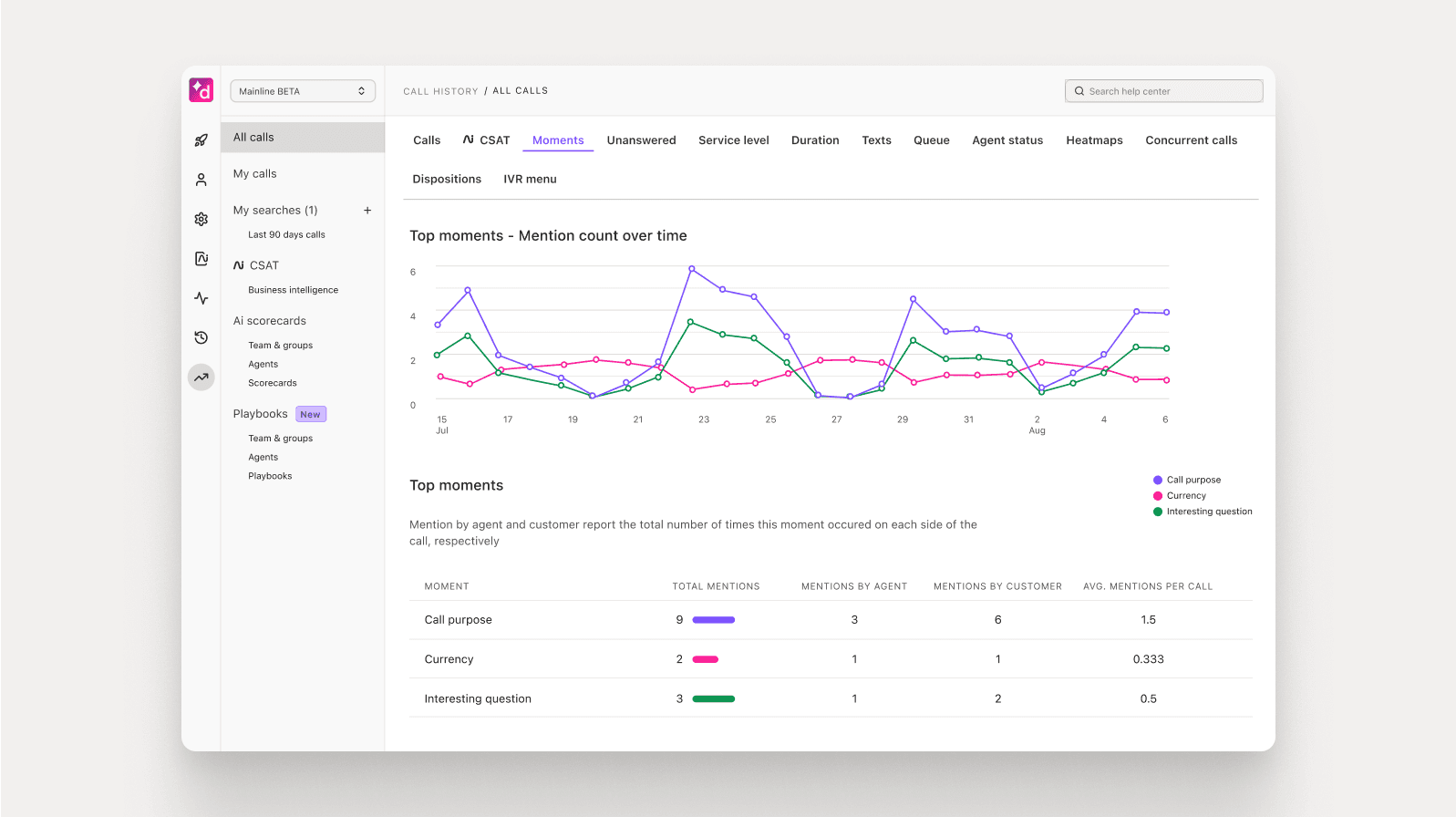
Omnichannel lets you meet customers where they are
If you want to deliver an exceptional customer experience, you need to meet people where they are—whether that’s via phone, live chat, social media, or another channel entirely. And if your customer engagement has shifted away from traditional voice calls, it may be time to think beyond a standard call center setup.
The good news is that expanding your channels doesn’t have to mean bloating your tech stack. With a unified platform like Dialpad Support, your team can manage every customer interaction—from voice to chat to social messaging—all in one place. No more juggling tabs or switching between tools.
True omnichannel support empowers your agents to work more efficiently, and gives your customers the flexibility they expect. It’s the smartest, most scalable way to modernize your contact center without sacrificing simplicity.
Want to see how Dialpad’s omnichannel contact center platform works?
See how it can make your contact center team’s lives easier with a demo or, take a self-guided interactive tour of the app!
